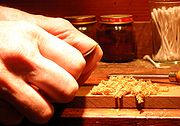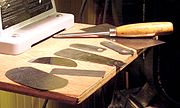
Card scraper
Encyclopedia

Woodworking
Woodworking is the process of building, making or carving something using wood.-History:Along with stone, mud, and animal parts, wood was one of the first materials worked by early humans. Microwear analysis of the Mousterian stone tools used by the Neanderthals show that many were used to work wood...
shaping and finishing
Wood finishing
Wood finishing refers to the process of embellishing and/or protecting the surface of a wooden material. The process starts with surface preparation, either by sanding by hand , scraping, or planing. Imperfections or nail holes on the surface may be filled using wood putty or pores may be filled...
tool. It is used to manually remove small amounts of material and excels in tricky grain
Wood grain
In speaking of wood the term grain refers to the alternating regions of relatively darker and lighter wood resulting from the differing growth parameters occurring in different seasons . The term is used in several ways. Perhaps most important is that in woodworking techniques...
areas where hand plane
Plane (tool)
A hand plane is a tool for shaping wood. When powered by electricity, the tool may be called a planer. Planes are used to flatten, reduce the thickness of, and impart a smooth surface to a rough piece of lumber or timber. Planing is used to produce horizontal, vertical, or inclined flat surfaces on...
s would cause tear out. Card scrapers are most suitable for working with hardwood
Hardwood
Hardwood is wood from angiosperm trees . It may also be used for those trees themselves: these are usually broad-leaved; in temperate and boreal latitudes they are mostly deciduous, but in tropics and subtropics mostly evergreen.Hardwood contrasts with softwood...
s, and can be used instead of sandpaper
Sandpaper
Sandpaper, also known as glasspaper, is a heavy paper with abrasive material attached to its surface.Sandpaper is part of the "coated abrasives" family of abrasive products. It is used to remove small amounts of material from surfaces, either to make them smoother , to remove a layer of material...
. Scraping produces a cleaner surface than sanding; it does not clog the pores of the wood with dust, and does not leave a fuzz of torn fibers, as even the finest abrasives will do.
Types of card scrapers

French curve
A French curve is a template made out of metal, wood or plastic composed of many different curves. It is used in manual drafting to draw smooth curves of varying radii....
and is useful for scraping curved surfaces. For scraping convex shapes such as violin
Violin
The violin is a string instrument, usually with four strings tuned in perfect fifths. It is the smallest, highest-pitched member of the violin family of string instruments, which includes the viola and cello....
fingerboard
Fingerboard
The fingerboard is a part of most stringed instruments. It is a thin, long strip of material, usually wood, that is laminated to the front of the neck of an instrument and above which the strings run...
s, small flexible rectangular scrapers are useful.
Scrapers are normally made from high carbon steel. There are many manufacturers who provide scrapers in a wide variety of styles. Many woodworkers prefer to make their own card scrapers by cutting them from old hand saw
Hand saw
In woodworking and carpentry, hand saws, also known as "panel saws", "fish saws", are used to cut pieces of wood into different shapes. This is usually done in order to join the pieces together and create a wooden object. They usually operate by having a series of sharp points of some substance...
blades.
Card scrapers are sometimes used in working with ceramics, where they may substitute for the more traditional wooden rib. The scraper is also useful for trimming damp or dry clay. Such a scraper, the nearest one to the camera, is shown in the image at right.
Turning the burr
The cutting component of a card scraper is the burred edge of the scraper. The burr is a sharp hook of metal which is turned on the edge of the scraper by burnishing with a steel rod. A fileFile (tool)
A file is a metalworking and woodworking tool used to cut fine amounts of material from a workpiece. It most commonly refers to the hand tool style, which takes the form of a steel bar with a case hardened surface and a series of sharp, parallel teeth. Most files have a narrow, pointed tang at one...
or sharpening stone
Sharpening stone
Sharpening stones, water stones or whetstones are used to grind and hone the edges of steel tools and implements. Examples of items that may be sharpened with a sharpening stone include scissors, scythes, knives, razors and tools such as chisels, hand scrapers and plane blades...
is used to joint
Jointing (sharpening)
Jointing refers to the process of filing or grinding the teeth or knives of cutting tools prior to sharpening. The purpose of jointing is to ensure that all surfaces to be sharpened are of a consistent size and all imperfections have been removed....
the edge of the scraper before burnishing. Cabinet makers typically joint the edge square, or at a right angle to the face of the scraper, which allows a fine burr to be turned on both sides. Luthier
Luthier
A luthier is someone who makes or repairs lutes and other string instruments. In the United States, the term is used interchangeably with a term for the specialty of each maker, such as violinmaker, guitar maker, lute maker, etc...
s often use a bevel
Bevel
A beveled edge refers to an edge of a structure that is not perpendicular to the faces of the piece. The words bevel and chamfer overlap in usage; in general usage they are often interchanged, while in technical usage they may sometimes be differentiated as shown in the image at right.-Cutting...
ed edge, which allows a more aggressive burr, but on one side only.
There are a number of variations in the process of turning the burr, the choice of which is down to personal preference. However the basic concept is that the burnishing rod is held against the edge of the scraper at a slight angle and drawn along the edge a number of times until the burr is created.
One variation involves holding the rod flat against the side of the scraper for the first few passes to create a burr pointing away from the edge and this is then rolled back down by drawing the rod along perpendicular to the scraper.
With the burr properly turned, a scraper will produce miniature shavings resembling those from a plane. If dust is produced, either the scraper is not sharp, or not being used correctly.
Use
In use, the card scraper is grasped by the fingers, one hand on either side, and tilted in the direction of travel. The degree of tilt controls the effective angle of the cutting edge, which is the burr. Practice is required to find the correct angle. In addition to the tilt, the user will usually flex the scraper slightly by holding it at the edges with the fingers and pressing in the centre with the thumbs. The slight flex causes the corners of the scraper to lift slightly thus preventing them from marring the workpiece.The scraper may be drawn towards the user or pushed away, although some woodworkers claim that pulling the scraper towards one can cause it to dip, resulting in an uneven surface.
The main drawback of a card scraper is that the usage is a difficult skill to master. It takes a bit of practice to turn the burr correctly and then the scraper must be presented to the work in the correct fashion. Also, due to the friction created in use, the card scraper can become hot enough to burn fingers.
A variation of the card scraper is the scraper plane which consists of a hand plane body in which a card scraper is mounted. There are also various styles of holder which can be used for this purpose. These simplify the use of the card scraper and alleviate the problems associated with heat.
Burnishing jigs and other accessories are available to assist in turning the burr, which makes the card scraper more accessible to the novice.
External links
- Using Card Scrapers
- Sharpening and Burnishing a Scraper - Step by step instructions for quickly getting a hand scraper ready for use, from the Mottola Lutherie (guitarmaking) Information Website.

